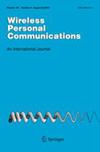波动衰减分布
IF 2.2
4区 计算机科学
Q3 TELECOMMUNICATIONS
引用次数: 0
摘要
Badarneh 和 da Costa(IEEE Wirel Commun Lett, 2024. https://doi.org/10.1109/LWC.2024.3353620)通过将信号包络作为两个独立随机变量(一个是中上 m 分布,另一个是均匀随机变量)之比,引入了波动衰减分布。Nakagami m 分布对应于正态分布的信号,但在实际应用中并不总是成立的。在本文中,我们还推导出其他二十种波动衰减分布。对于每种分布,我们都给出了平均信道容量和平均误码率的明确表达式。我们用数字检验了它们的正确性。本文章由计算机程序翻译,如有差异,请以英文原文为准。

Fluctuating Fading Distributions
Badarneh and da Costa (IEEE Wirel Commun Lett, 2024. https://doi.org/10.1109/LWC.2024.3353620) introduced the fluctuating fading distribution by taking the signal envelope to be the ratio of two independent random variables, one having the Nakagami m distribution and the other a uniform random variable. The Nakagami m distribution corresponds to signals following the normal distribution which may not always hold in practice. In this paper, we derive twenty other fluctuating fading distributions. For each distribution, we give explicit expressions for the average channel capacity and the average bit error rate. Their correctness is checked numerically.
求助全文
通过发布文献求助,成功后即可免费获取论文全文。
去求助
来源期刊

Wireless Personal Communications
工程技术-电信学
CiteScore
5.80
自引率
9.10%
发文量
663
审稿时长
6.8 months
期刊介绍:
The Journal on Mobile Communication and Computing ...
Publishes tutorial, survey, and original research papers addressing mobile communications and computing;
Investigates theoretical, engineering, and experimental aspects of radio communications, voice, data, images, and multimedia;
Explores propagation, system models, speech and image coding, multiple access techniques, protocols, performance evaluation, radio local area networks, and networking and architectures, etc.;
98% of authors who answered a survey reported that they would definitely publish or probably publish in the journal again.
Wireless Personal Communications is an archival, peer reviewed, scientific and technical journal addressing mobile communications and computing. It investigates theoretical, engineering, and experimental aspects of radio communications, voice, data, images, and multimedia. A partial list of topics included in the journal is: propagation, system models, speech and image coding, multiple access techniques, protocols performance evaluation, radio local area networks, and networking and architectures.
In addition to the above mentioned areas, the journal also accepts papers that deal with interdisciplinary aspects of wireless communications along with: big data and analytics, business and economy, society, and the environment.
The journal features five principal types of papers: full technical papers, short papers, technical aspects of policy and standardization, letters offering new research thoughts and experimental ideas, and invited papers on important and emerging topics authored by renowned experts.
 求助内容:
求助内容: 应助结果提醒方式:
应助结果提醒方式:


